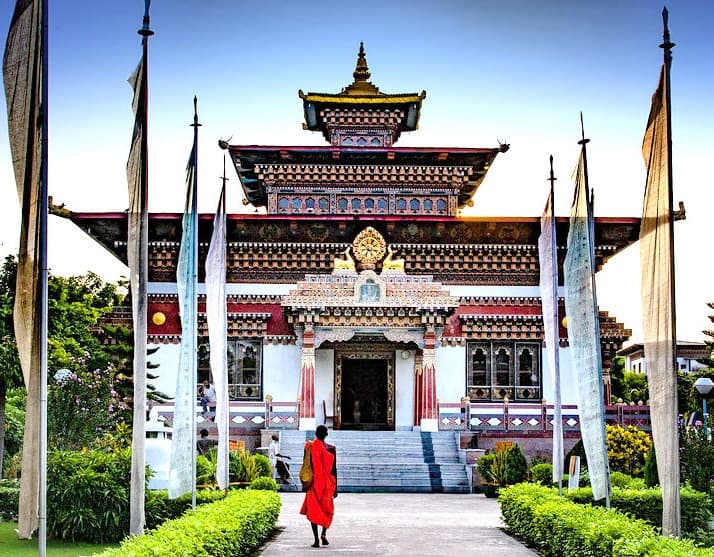- Remote and Pristine Landscapes
- Challenging High Passes
- Diverse Flora and Fauna
- Cultural Immersion
- Spectacular Mountain Views
- Lunana Region
- Therapeutic Hot Springs
- Spiritual Experiences
- Changing Sceneries
- Sense of Achievement
- Best time for Snowman Trekking
- Essential Tips for Snowman Trekking
- FAQs of Snowman Trekking
The Snowman Trek Bhutan is renowned as one of the most challenging and rewarding high-altitude treks in the world. This extensive journey takes adventurers through some of Bhutan's most remote and stunning landscapes, offering unparalleled views of majestic mountains and pristine wilderness. The Snowman Trek itinerary spans about 25-30 days, covering difficult terrains and multiple passes over 5,000 meters. Ideal for the seasoned trekker, this path not only tests your endurance but also immerses you in the rich cultural heritage of Bhutan. The best time for Snowman Trek is during October and November when the weather conditions are most favorable. For those planning this adventure, thorough Snowman Trek preparation is essential, including securing Snowman Trek permits and understanding the Snowman Trek cost. With its breathtaking vistas and rigorous demands, the Snowman Trek stands out as a pinnacle of Bhutan trekking adventures.
At Druk Holidays, we pride ourselves on being the premier choice for experiencing the Snowman Trek Bhutan. Our expertise in high-altitude trekking and comprehensive knowledge of Bhutan’s rugged landscapes make us the best Snowman Trek tour operators. We meticulously plan every detail of the Snowman Trek itinerary, ensuring our adventurers are well-prepared with the right Snowman Trek preparation, guidance, and support throughout this challenging journey. Choosing Druk Holidays means opting for an unparalleled adventure with a focus on safety, quality, and an authentic immersion into the heart of Bhutan’s natural and cultural beauty. Trust us to make your Snowman Trek experience truly unforgettable.
Remote and Pristine Landscapes
The Snowman Trek offers trekkers a unique opportunity to traverse some of Bhutan's most remote and pristine landscapes, rarely touched by modernization and far from the usual tourist trails. This journey not only challenges your physical limits but also allows you to experience untouched natural beauty in its most raw form.
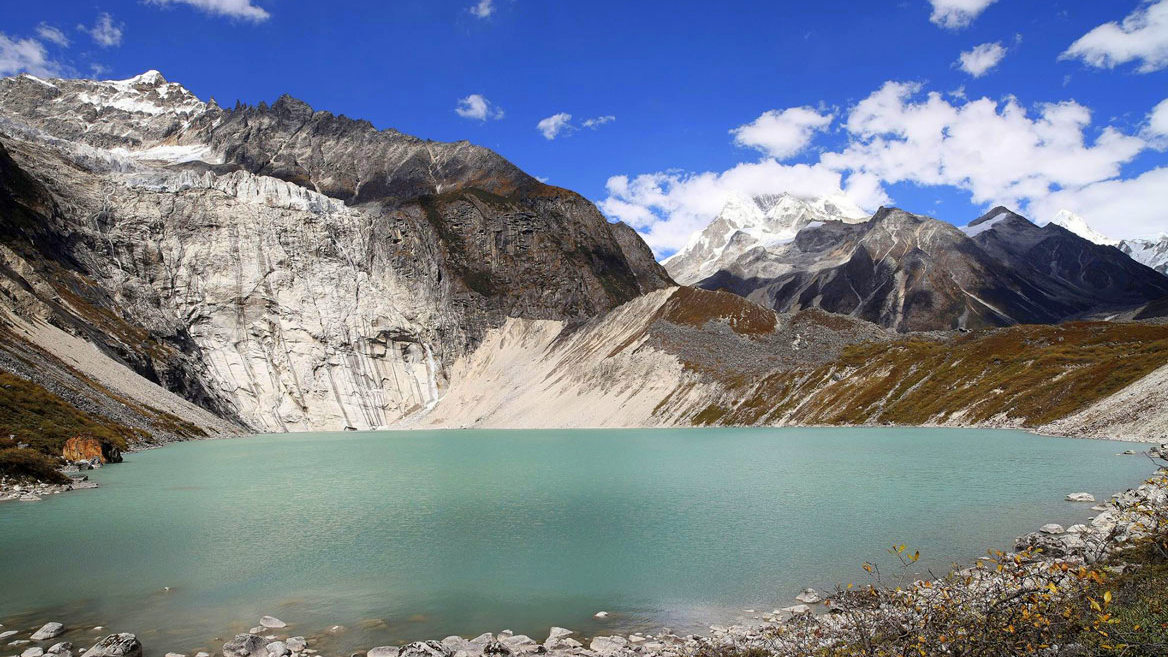
- Untouched Wilderness: The trek moves through areas that are virtually untouched by human presence, offering a landscape that remains as it has been for centuries.
- Diverse Ecosystems: From dense rhododendron forests to high-altitude tundra, the ecosystems along the Snowman Trek are as varied as they are vibrant.
- Floral and Faunal Biodiversity: These remote landscapes are home to a variety of wildlife including endemic species, offering trekkers glimpses of creatures such as the Bhutan takin, snow leopards, and red pandas.
- Natural Tranquility: The isolation of the trek routes provides a peaceful experience, far removed from the noise and distractions of populated areas.
- Crystal-Clear Rivers and Lakes: Encounter sparkling rivers and high-altitude lakes that reflect the clear blue skies and surrounding mountain peaks in their pristine waters.
- Stunning Photographic Opportunities: The untouched quality of the landscapes makes for breathtaking photography, capturing the essence of Bhutan's natural heritage.
- Eco-Sensitive Trekking: Trekking through these areas involves a high degree of eco-responsibility, preserving the pristine condition of the environment.
The remote and pristine landscapes encountered on the Snowman Trek offer more than just a physical challenge; they provide a profound connection to nature that is increasingly rare today. Each step through this untouched wilderness brings a deeper appreciation for the natural world and the need to protect these extraordinary ecosystems for future generations.
Challenging High Passes
The Snowman Trek is notorious for its challenging high passes, which are among the most daunting yet exhilarating aspects of trekking in the Bhutanese Himalayas. These passes not only test the mettle of even the most seasoned trekkers but also offer some of the most spectacular views available.
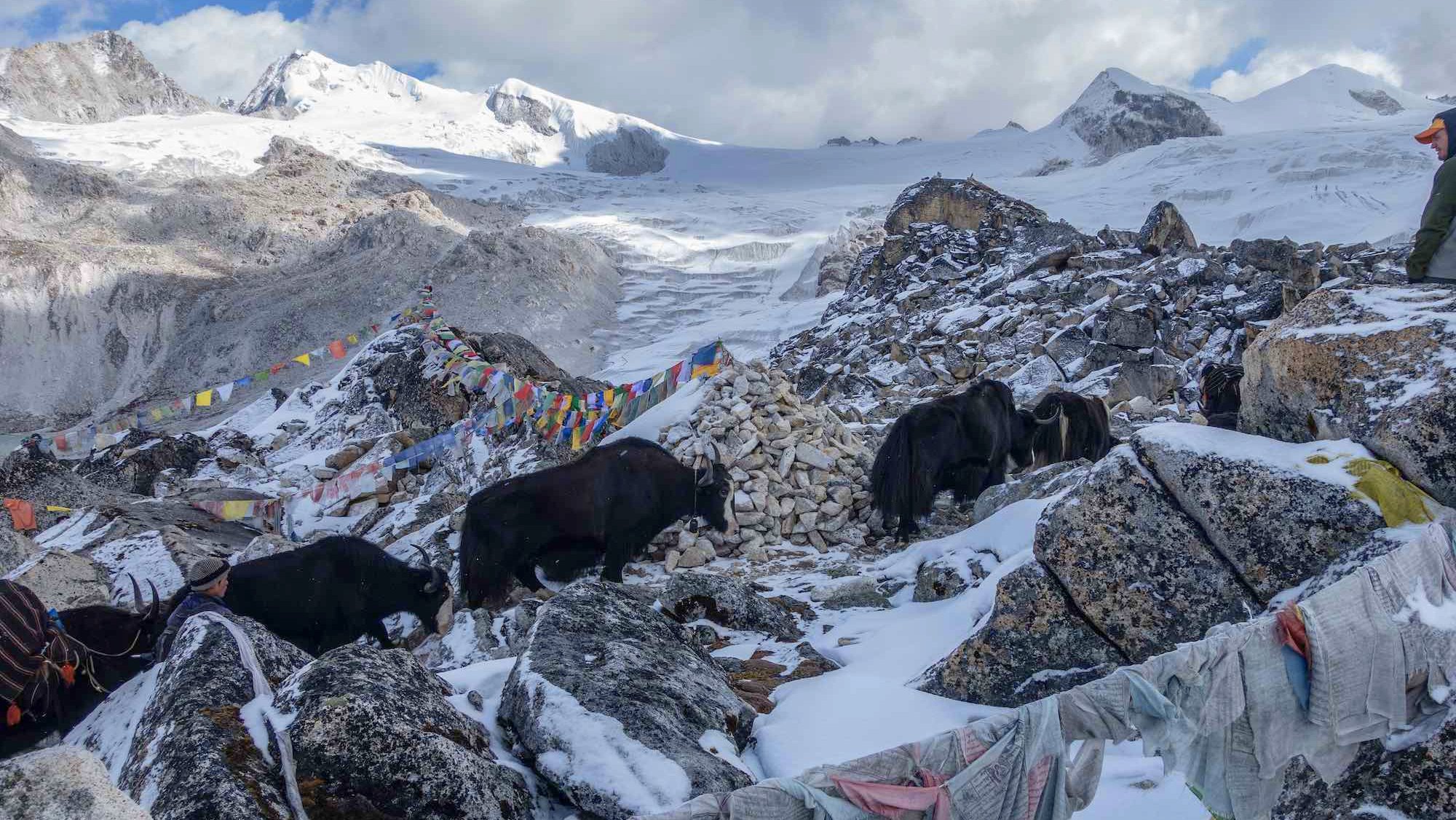
- Rinchen Zoe Pass: At an elevation of 5,320 meters, Rinchen Zoe Pass is the highest and one of the most challenging passes on the Snowman Trek. It offers breathtaking panoramic views of the surrounding Himalayan peaks.
- Numerous Mountain Passes: The trek involves crossing multiple passes over 5,000 meters, each presenting unique challenges and vistas. These include Nyile La, Gobu La, and Jaze La, among others.
- Variable Weather Conditions: The high altitude of these passes means weather can change rapidly, adding an element of unpredictability and adventure to the trek.
- Physical and Mental Test: The altitude and difficulty of these passes test the physical fitness, stamina, and mental resilience of trekkers, contributing to the overall challenge of the Snowman Trek.
- Sense of Achievement: Successfully navigating these high passes provides a significant sense of accomplishment given their difficulty and the extreme conditions often faced.
- Striking Landscapes: Each pass offers unique and striking landscapes, from snow-covered peaks to expansive views of remote valleys and high-altitude wilderness.
- Cultural Significance: Many of the passes hold cultural significance for the local communities, often marked by prayer flags and chortens, adding a spiritual element to the challenge.
Navigating the challenging high passes of the Snowman Trek is a highlight that attracts thrill-seekers and adventure lovers to this trek, promising not only physical and mental challenges but also rewarding them with some of the most awe-inspiring views and a profound sense of accomplishment.
Diverse Flora and Fauna
The Snowman Trek traverses through some of the most biodiverse regions in the Himalayas, showcasing an impressive array of diverse flora and fauna. This ecological variety is a significant draw for nature enthusiasts and adds a rich layer of experience to the physical challenge of the trek.
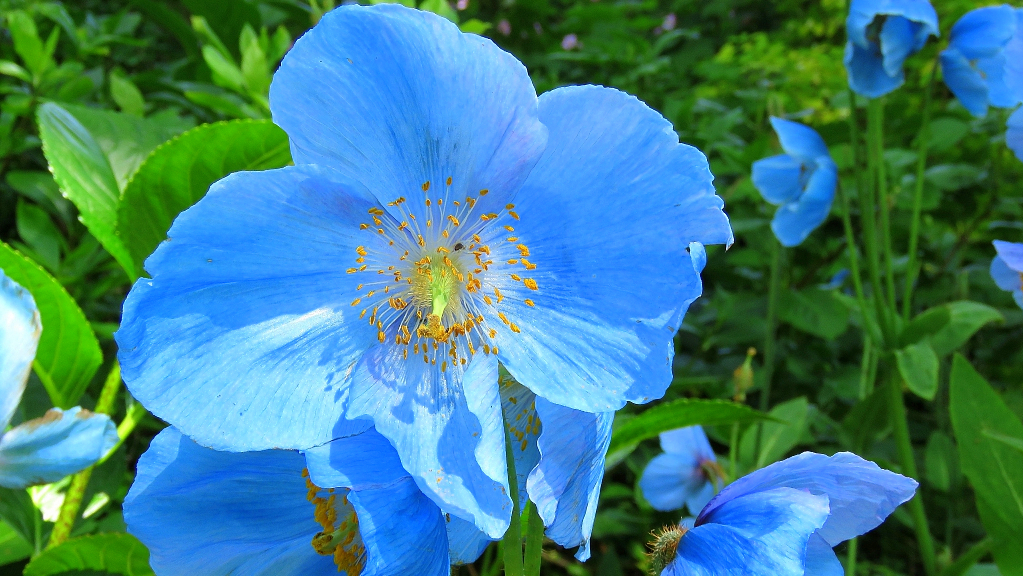
- Alpine Flora: As you ascend through various climate zones, you’ll encounter a shifting panorama of plant life, from dense forests of blue pine and cedar to subalpine zones dominated by rhododendrons and junipers, and finally to alpine meadows bursting with edelweiss and other hardy species.
- Rare Wildlife Sightings: The isolation and untouched nature of the landscapes along the Snowman Trek increase the likelihood of encountering rare and endangered species. Trekkers might spot the elusive snow leopard, Himalayan blue sheep, or the unique Bhutan takin.
- Birdwatching Opportunities: The trek is a paradise for birdwatchers, with the possibility to observe a variety of bird species, including the Himalayan monal, blood pheasant, and various types of eagles and vultures that roam the high skies.
- Medicinal and Aromatic Plants: The region is rich in medicinal herbs and plants used in traditional Bhutanese and Tibetan medicine. Knowledgeable guides can provide insights into the uses of specific flora encountered along the trail.
- Bhutan’s National Flower: The trek offers the chance to see the famous blue poppy, Bhutan’s national flower, especially if trekking during the blooming season in early summer.
- Ecosystem Conservation: Trekking through this protected area helps support conservation efforts, preserving the natural habitat for future generations while fostering a deeper appreciation for wildlife conservation among visitors.
- Interaction with Natural Elements: The close interaction with nature throughout the trek not only educates trekkers about Himalayan ecosystems but also offers moments of reflection and connection with the natural world.
The diverse flora and fauna along the Snowman Trek not only enhance the visual and sensory experience of the journey but also play a crucial role in the ecological health and sustainability of the region. This rich biodiversity is integral to the unique and transformative nature of the trek, leaving lasting impressions on those who traverse its paths.
Cultural Immersion
The Snowman Trek offers a profound opportunity for cultural immersion, allowing trekkers to deeply engage with the heritage and traditions of the remote communities in Bhutan. This aspect of the trek enhances the journey, turning it into a transformative experience that goes beyond physical endurance.
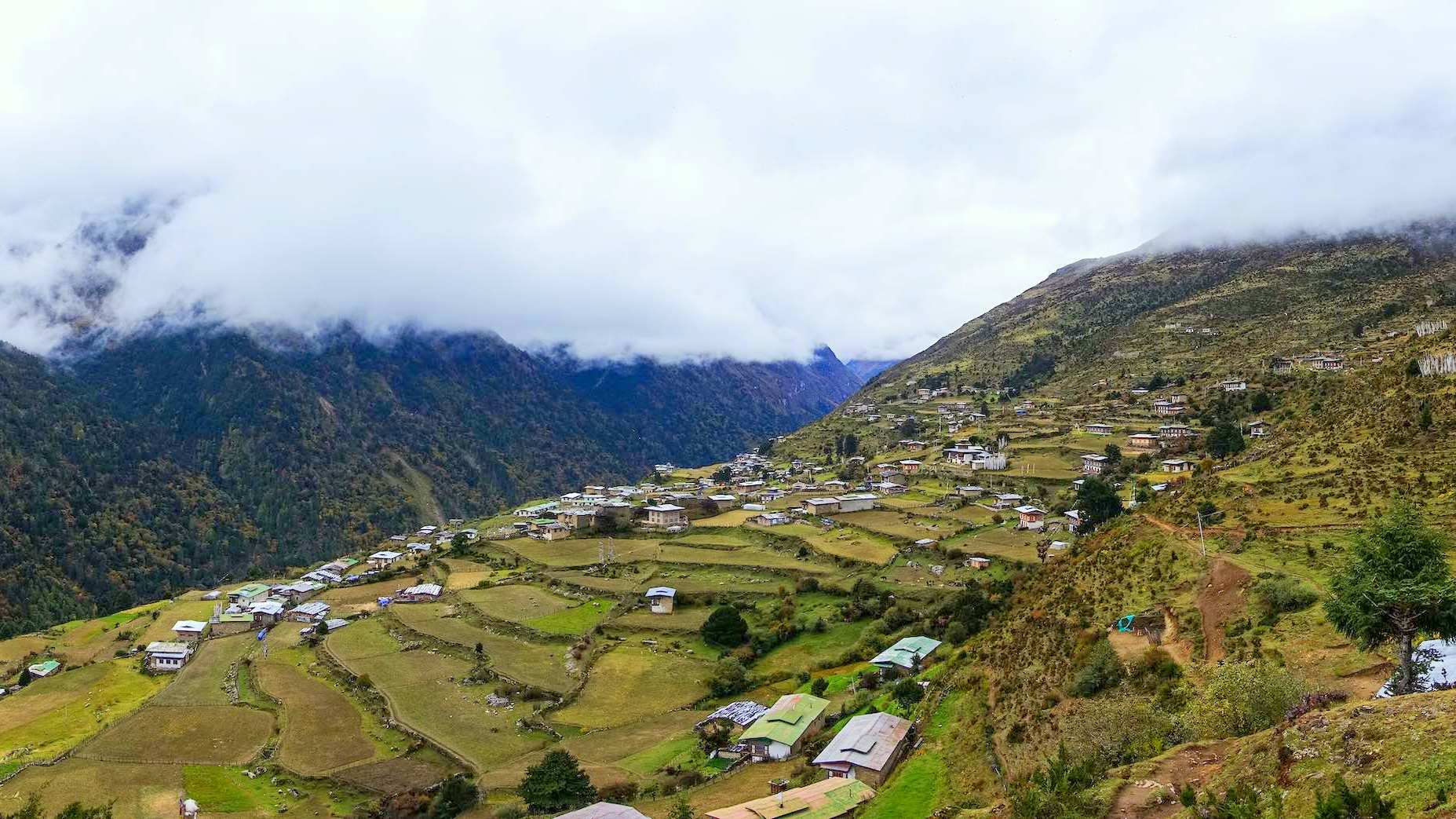
- Visiting Remote Villages: Trek routes pass through isolated villages such as Laya and Lunana, where trekkers can observe and participate in the daily lives of the indigenous communities. This interaction provides insights into traditional Bhutanese lifestyles that have remained unchanged for centuries.
- Monastic Life: The trek offers visits to ancient monasteries and sacred sites, including some that are rarely visited by outsiders. These visits allow trekkers to witness monastic life firsthand and understand the spiritual practices that are central to Bhutanese culture.
- Traditional Architecture: Along the way, trekkers encounter traditional Bhutanese architecture in the form of dzongs (fortresses), chortens (stupas), and unique village houses, each telling a story of Bhutan's rich historical and architectural heritage.
- Festivals and Celebrations: If timed right, trekkers can experience local festivals such as the Laya Runa Festival, where communities celebrate with traditional attire, music, and dance, offering a colorful glimpse into Bhutanese cultural festivities.
- Handicrafts and Artisans: Interaction with local artisans who specialize in weaving, pottery, and other traditional crafts provides an understanding of the artistic skills passed down through generations and the importance of handicrafts in Bhutanese economy and culture.
- Language and Communication: Engaging with locals, often with the help of guides, gives trekkers the chance to learn basic Dzongkha phrases, enhancing communication and enriching the travel experience.
- Culinary Experiences: The trek introduces participants to authentic Bhutanese cuisine, featuring dishes made from local ingredients and traditional methods. This culinary journey is an integral part of the cultural experience.
The cultural immersion experienced on the Snowman Trek is as challenging and rewarding as the physical trek itself. It offers a rare insight into the heart and soul of Bhutan, showcasing the traditions, beliefs, and hospitality of the Bhutanese people, making the journey an unforgettable exploration of both landscape and culture.
Spectacular Mountain Views
The Snowman Trek is renowned not only for its challenging terrain but also for the spectacular mountain views it offers, which are among the most majestic in the world. These views serve as a reward for the physical demands of the trek and provide unforgettable moments that resonate long after the journey ends.
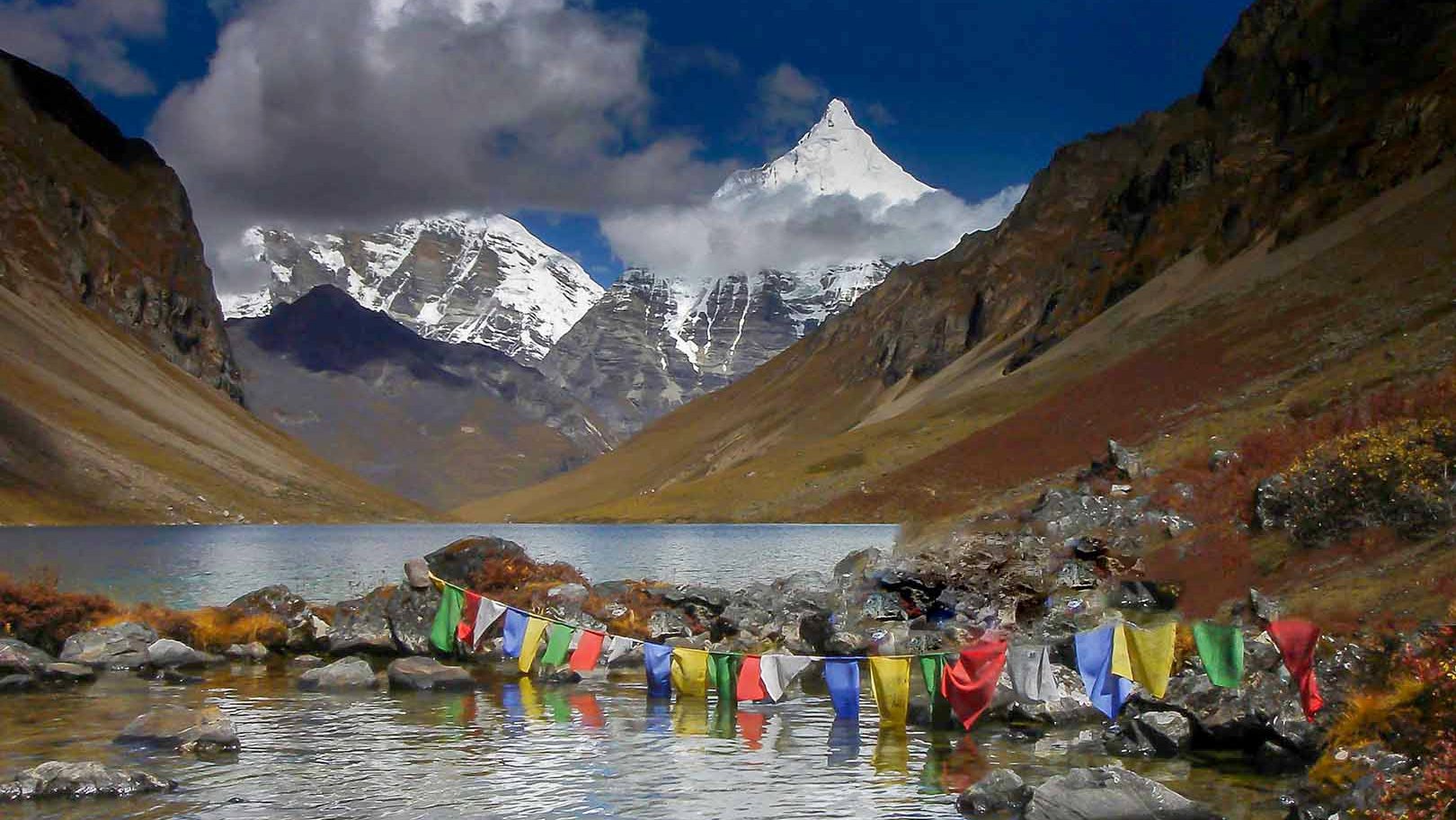
- Panoramic Himalayan Ranges: The trek provides panoramic views of the Himalayan range, including some of Bhutan’s and the world’s highest and most beautiful peaks.
- Gangkhar Puensum: Trekkers can catch glimpses of Gangkhar Puensum, the highest unclimbed mountain in the world, an awe-inspiring sight that adds a sense of mystery and allure to the trek.
- Jomolhari and Jichu Drake: These iconic peaks are visible at various points along the trek, offering dramatic backdrops and excellent opportunities for photography.
- Remote Valleys: As you traverse high mountain passes, you'll overlook remote valleys that seem untouched by time, where the beauty of nature is displayed in its most pristine form.
- Sunrise and Sunset Views: Experiencing sunrise or sunset from high altitudes, with the Himalayan mountains bathed in golden hues, is a highlight for many trekkers and a profound moment of connection with nature.
- Ever-Changing Scenery: As the trek progresses, the scenery continuously changes, offering diverse views that range from rugged mountain vistas to sweeping landscapes dotted with wildflowers and vibrant greenery during the summer months.
- Snow-Capped Peaks: The stark contrast of snow-capped peaks against deep blue skies provides a stunning visual spectacle that embodies the rugged beauty of the high Himalayas.
These spectacular mountain views on the Snowman Trek not only enhance the trekking experience but also provide moments of awe and inspiration. They are reminders of the grandeur of the natural world and the extraordinary beauty that lies in the remote corners of Bhutan.
Lunana Region
The Lunana Region is one of the most remote and enchanting areas traversed during the Snowman Trek. This secluded part of Bhutan offers a mix of natural beauty and cultural richness, making it a highlight for many trekkers who undertake this challenging journey.
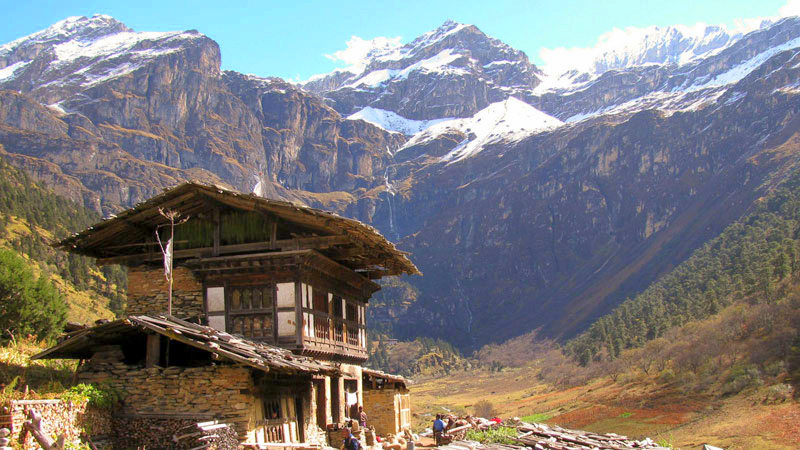
- Isolation and Serenity: Lunana is one of the least accessible regions in Bhutan, offering trekkers a true sense of isolation and serenity amidst some of the world’s most stunning landscapes.
- Traditional Lifestyle: The inhabitants of Lunana live a lifestyle that has remained largely unchanged for centuries. Their traditional practices, homes, and subsistence farming techniques offer trekkers a glimpse into the enduring cultural heritage of Bhutan.
- Stunning Glacial Lakes: The region is dotted with beautiful glacial lakes, including Thanza, one of the largest and most beautiful in Bhutan. These lakes are visually stunning and play a crucial role in the local folklore and ecology.
- High-Altitude Villages: Villages such as Thanza, Lhedi, and Chozo are situated at altitudes exceeding 4,000 meters, presenting unique challenges and ways of life adapted to the harsh mountain environment.
- Rare Wildlife: The isolated valleys and high-altitude pastures of Lunana are home to unique wildlife, including the elusive snow leopard, Himalayan blue sheep, and the Bhutan takin, providing exciting possibilities for wildlife sightings.
- Rugged Mountain Peaks: The region is surrounded by some of the highest unclimbed peaks in the world, offering awe-inspiring views and a rugged backdrop that defines the trek.
- Spiritual Sites: Lunana is rich in spiritual significance with numerous sacred sites and monasteries that reflect the deep Buddhist traditions of the area, providing spiritual depth to the trekking experience.
Exploring the Lunana Region during the Snowman Trek provides an unforgettable adventure into one of Bhutan’s most pristine and untouched landscapes. It offers a rare blend of natural beauty, cultural encounters, and spiritual enrichment that is central to the transformative experience of trekking in Bhutan.
Therapeutic Hot Springs
The Snowman Trek offers more than just challenging trails and stunning vistas; it also presents opportunities for trekkers to rejuvenate in therapeutic hot springs along the route. These natural springs are not only a highlight for their soothing properties but also add a unique and welcome contrast to the demanding physical aspects of the trek.
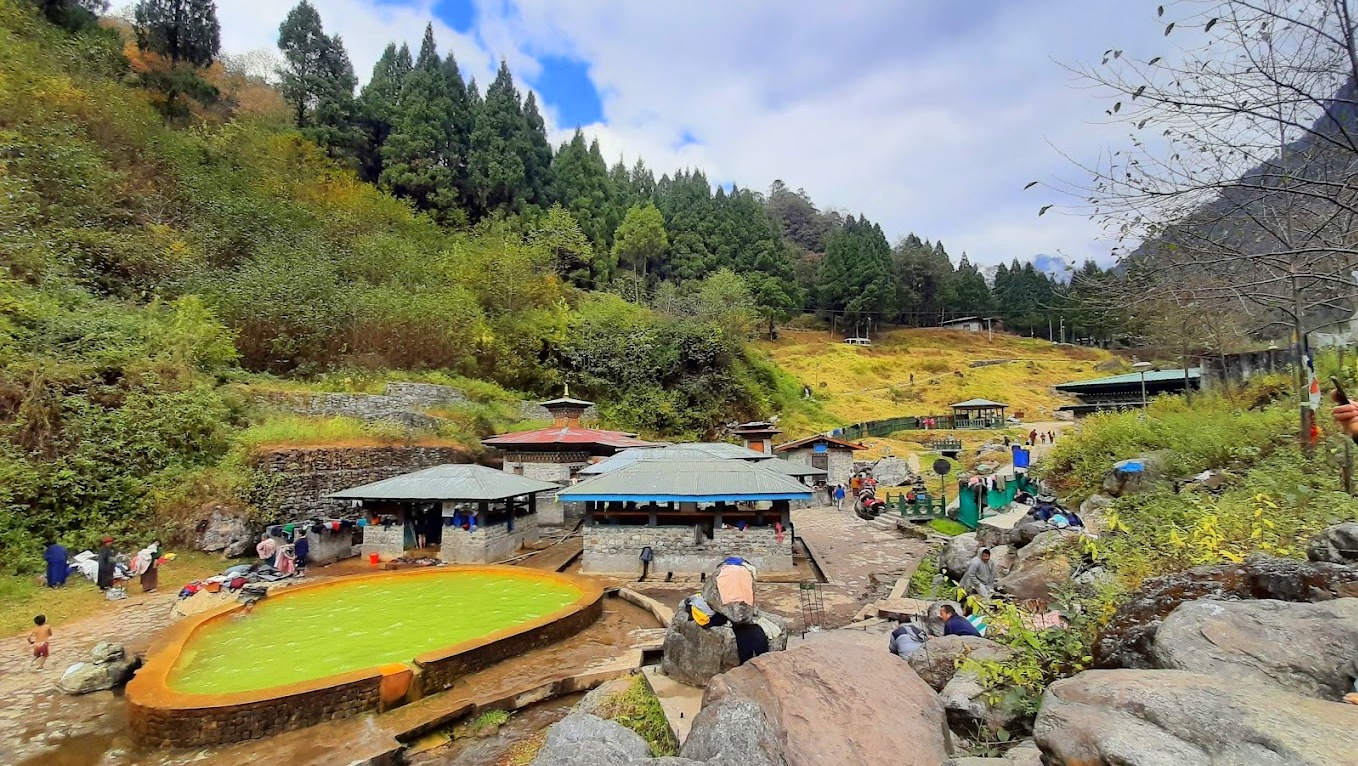
- Gasa Hot Springs: Perhaps the most famous along the trek, the Gasa Hot Springs are a well-loved stop. Situated near the banks of the Mo Chhu River, these hot springs offer a therapeutic soak that is believed to have healing properties for aching muscles and joints.
- Lunana Hot Springs: Found within the remote Lunana region, these less frequented hot springs provide a secluded and intimate experience for trekkers looking to relax in the middle of a rugged landscape.
- Healing Properties: The mineral-rich waters of these hot springs are renowned for their health benefits, including improved circulation, reduced stress, and relief from rheumatism and muscle pain.
- Cultural Significance: Hot springs hold a special place in Bhutanese culture as sites of healing and spiritual significance. Locals often visit these springs for both physical well-being and spiritual cleansing.
- Social Interaction: Visiting these hot springs allows trekkers to mingle with locals and fellow trekkers alike, sharing stories and experiences in a warm and relaxing environment.
- Natural Setting: The springs are typically surrounded by beautiful natural scenery, providing a peaceful and picturesque setting to unwind after the strenuous parts of the trek.
- Enhanced Trekking Experience: Incorporating stops at these hot springs can greatly enhance the overall trekking experience, offering a balance between physical challenge and relaxation.
The inclusion of therapeutic hot springs in the Snowman Trek not only provides physical relief and recovery for trekkers but also enriches the journey with cultural insights and a chance to connect with nature in a deeply relaxing setting.
Spiritual Experiences
The Snowman Trek is not only a physical challenge but also a profound journey filled with spiritual experiences. This trek offers unique opportunities to engage with the deeply rooted Buddhist traditions of Bhutan, making it a journey of inner discovery as well as outer exploration.
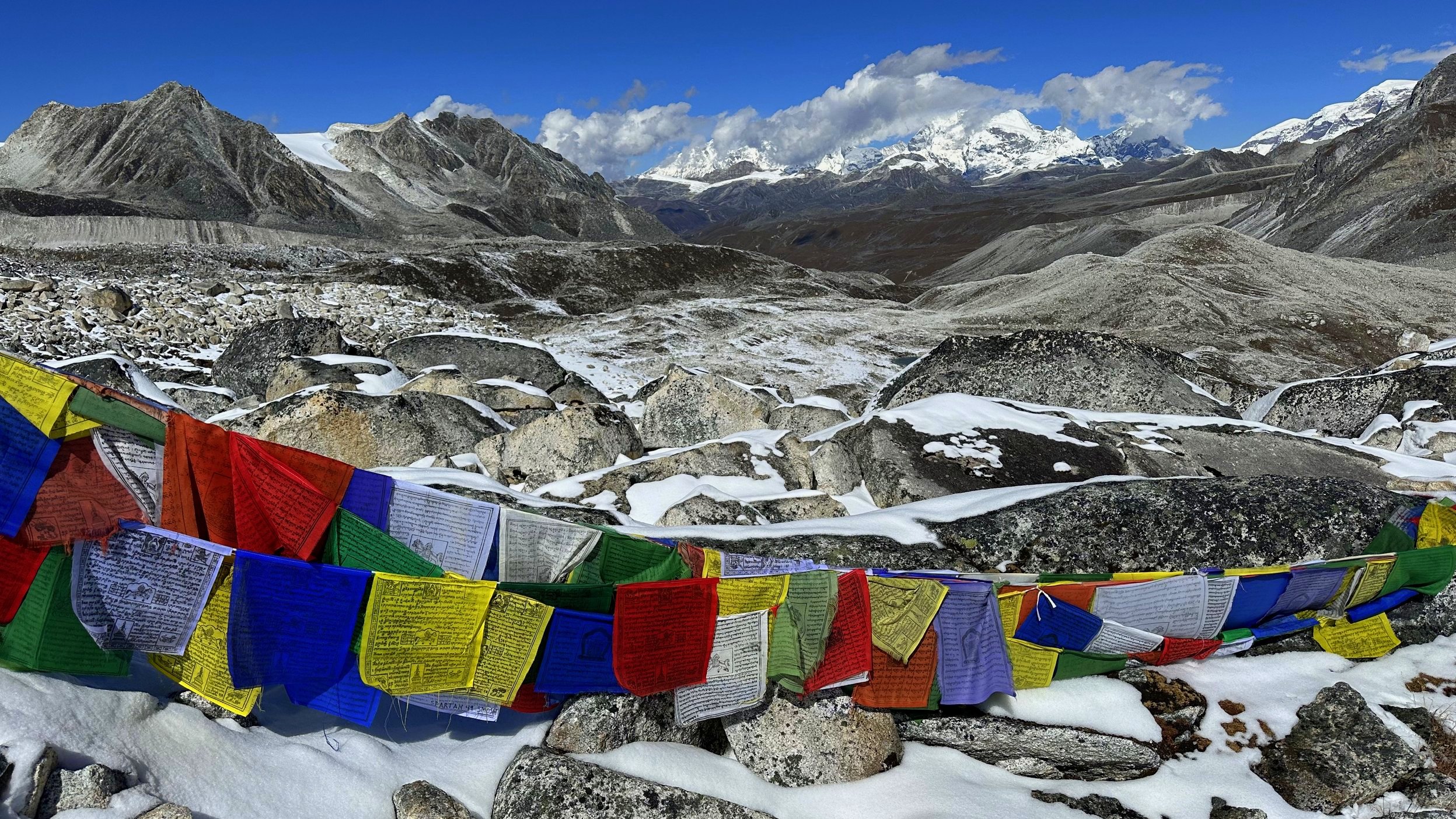
- Ancient Monasteries and Temples: Along the route, trekkers visit age-old monasteries and temples, such as the remote Lhedi Monastery. These sacred sites are active centers of Buddhist practice and offer a glimpse into the spiritual rituals and practices that have shaped Bhutanese culture.
- Prayer Flags and Chortens: The path is dotted with colorful prayer flags that flutter in the wind, sending out prayers and blessings. Chortens (stupas) are also prevalent along the trek, serving as reminders of the Buddhist path of enlightenment.
- Meditative Environment: The natural silence and solitude found in the high Himalayas create a perfect environment for meditation and reflection. Many trekkers find this setting ideal for personal introspection and spiritual connection.
- Buddhist Teachings and Stories: Interaction with local monks and the lay community often leads to discussions on Buddhist philosophy and teachings. These interactions can offer insights into the concepts of impermanence and interdependence, central to Buddhist thought.
- Festival Participation: If timed with local religious festivals, trekkers can witness and even participate in these vibrant and spiritually significant events, which are a profound expression of Bhutanese culture and religious practice.
- Pilgrimage Sites: Some sections of the trek are considered pilgrimage routes, where trekkers can engage in circumambulation and other merit-earning activities, following in the footsteps of devout pilgrims.
- Natural Beauty as a Spiritual Experience: The awe-inspiring beauty of the landscapes themselves often evokes a sense of wonder and spiritual awe, fostering a deep connection with the earth and its energies.
The spiritual experiences offered by the Snowman Trek elevate it from a mere physical endeavor to a transformative journey that nourishes the soul and deepens one’s spiritual awareness. This aspect of the trek makes it particularly memorable and rewarding for those seeking not only adventure but also spiritual enrichment.
Changing Sceneries
The Snowman Trek in Bhutan is renowned not only for its rigorous demands but also for the changing sceneries that unfold with each step of the journey. This dynamic landscape variation significantly enhances the trekking experience, providing visual delights and new environments to explore every day.
- Diverse Ecosystems: The trek traverses a variety of ecosystems, starting from lush, subtropical forests at lower altitudes, moving through temperate zones with thick rhododendron forests, and culminating in the stark, high-altitude alpine environments.
- Floral Changes: As trekkers ascend, the flora transitions dramatically. Spring treks are marked by blooming rhododendrons and wildflowers, while autumn treks showcase the brilliant colors of seasonal foliage changes.
- Mountain Vistas: The views of the Himalayan range evolve daily. One moment trekkers might be admiring distant snow-capped peaks, and the next, they are walking beside these towering giants, providing a constantly shifting perspective of the landscape.
- River and Stream Crossings: The path crosses numerous rivers and streams, each with its own unique setting, from roaring waterfalls to tranquil, clear brooks. These water bodies add a dynamic element to the trek’s scenery.
- Glacial Features: Higher up, the terrain includes impressive glacial features such as moraines, icefalls, and occasional glacier sightings, contrasting sharply with the lush lower valleys.
- Cultural Landscapes: The trek also leads through varied cultural landscapes, from isolated mountain villages with their traditional architecture to sacred monastic sites, each adding a human element to the natural beauty.
- Weather and Light Conditions: The weather along the trek can change swiftly, dramatically altering the landscape’s appearance. Morning mists, clear sunny skies, and shifting cloud shadows play with the light and mood of the mountains and valleys, creating breathtaking views.
These changing sceneries on the Snowman Trek provide not just a backdrop for the journey but a dynamic and integral part of the trekking experience, keeping trekkers engaged and filled with anticipation for what lies ahead. Each new landscape brings its own challenges and rewards, making the Snowman Trek a continuously unfolding adventure.
Sense of Achievement
The Snowman Trek is one of the most challenging treks in the world, and completing it provides an unparalleled sense of achievement. This sense of accomplishment is derived not only from the physical exertion required but also from overcoming the mental and emotional challenges that such a demanding journey presents.
- Overcoming High Altitudes: Successfully navigating through numerous high-altitude passes, some over 5,000 meters, instills a profound sense of accomplishment. Each pass conquered is a testament to the trekker's endurance and resilience.
- Endurance and Resilience: The trek spans over 25-30 days of intense hiking through diverse and often harsh environments. Completing such a trek enhances one’s physical and mental stamina and showcases their ability to persevere through challenging conditions.
- Cultural Engagement: Engaging deeply with the local communities and experiencing Bhutanese culture firsthand enrich the journey, making the completion of the trek feel like a significant achievement in cultural immersion and understanding.
- Navigating Remote Terrains: The remoteness of the Snowman Trek adds to the challenge. Trekkers have to be self-sufficient and resourceful, and successfully navigating these areas offers a rewarding sense of self-reliance and adventure.
- Personal Growth: The trek offers numerous opportunities for personal reflection and development. Many trekkers find that they emerge from the experience with increased self-awareness and a new perspective on their capabilities and limits.
- Connection with Nature: The deep connection with the natural world experienced during the trek can be transformative. This connection, combined with the physical completion of the trek, heightens the overall sense of achievement.
- Joining an Elite Group: Due to its difficulty, only a small number of adventurers complete the Snowman Trek each year. Joining this elite group of trekkers is a badge of honor and a standout achievement in the trekking community.
The sense of achievement felt after completing the Snowman Trek is multi-faceted, combining physical, mental, and emotional victories. It is a celebration of what one can endure and overcome, and it leaves trekkers with lasting pride and unforgettable memories.
Best time for Snowman Trekking
The Snowman Trek in Bhutan is highly sensitive to seasonal changes, which significantly impact the accessibility and experience of the trek. Understanding the seasonal variations can help trekkers choose the best time for their journey.
Spring (March to May)
- Advantages: Spring is a vibrant time for the trek, with the weather generally stable and the paths clear of snow. This season also sees the blooming of rhododendrons and other wildflowers, adding a splash of color to the landscape.
- Considerations: Temperatures can still be quite cold, especially at higher altitudes, and late snowfall in March might affect pass accessibility.
Summer (June to August)
- Advantages: The valleys are lush and green, and the weather is warmer, which can make for more comfortable trekking conditions in the lower altitudes.
- Considerations: Summer is the monsoon season in Bhutan, which can lead to heavy rains, slippery trails, and obscured views. High-altitude sections of the trek may still be accessible and offer clearer skies above the rain clouds.
Autumn (September to November)
- Advantages: This is the best time for the Snowman Trek. The weather is stable and dry, offering clear blue skies and the best visibility. Temperatures are also more moderate, making high-altitude trekking more comfortable.
- Considerations: Autumn is a popular season for trekking, so the trails may be busier. Early snowfall in late November can sometimes pose challenges.
Winter (December to February)
- Advantages: The landscapes are stark and beautiful with snow, providing a different kind of trekking experience that's quiet and solitary.
- Considerations: Winter is extremely cold, especially at higher altitudes, making many passes inaccessible due to heavy snow. Only the most experienced trekkers should consider this season, and even then, with ample preparation for harsh conditions.
For most trekkers, autumn offers the optimal conditions for the Snowman Trek, combining good weather, excellent visibility, and relatively stable trekking conditions. However, choosing the right time also depends on personal preferences regarding scenery, solitude, and weather conditions.
Essential Tips for Snowman Trekking
The Snowman Trek in Bhutan is one of the most challenging treks in the world, requiring meticulous preparation and a strong determination. Here are 10 essential tips to help ensure a successful and enjoyable trekking experience:
- Physical Preparation: Start training at least six months in advance. Focus on cardiovascular fitness, strength training, and endurance exercises. Include plenty of long walks or hikes in your routine, ideally in hilly or mountainous terrain.
- Mental Preparation: Prepare mentally for the challenges ahead. Familiarize yourself with the trek’s itinerary, understand the physical and mental demands, and mentally commit to the challenge.
- Proper Gear: Invest in high-quality trekking gear. Essential items include a sturdy pair of hiking boots, a warm sleeping bag suitable for sub-zero temperatures, a durable backpack, and layers of clothing for varying weather conditions.
- Altitude Acclimatization: Plan your itinerary to allow gradual acclimatization to high altitudes. Consider pre-trek altitude training or spend a few days at high altitude before starting the trek to reduce the risk of altitude sickness.
- Hydration and Nutrition: Stay hydrated and maintain a balanced diet. The cold and exertion can suppress your thirst and appetite, but drinking plenty of water and eating enough calories is crucial for maintaining your energy levels.
- Guide and Porter Services: Hire experienced guides and porters through a reliable trekking company. Not only do they provide logistical support, but they are also invaluable for their knowledge of the terrain, weather conditions, and local culture.
- Travel Insurance: Ensure that your travel insurance covers high-altitude trekking and medical evacuation. Check the specifics of your policy to ensure it meets the trek’s requirements.
- Understand the Risks: Be aware of the potential risks, including altitude sickness, harsh weather conditions, and remote terrain. Prepare contingency plans for emergencies.
- Respect Local Customs: Bhutan has a deeply religious and unique culture. Show respect for local traditions, religious practices, and community rules. Dress modestly and behave respectfully, especially in monasteries and villages.
- Leave No Trace: Practice responsible trekking by minimizing your environmental impact. Carry out all your trash, use biodegradable products, and respect wildlife and natural habitats.
Following these tips can significantly enhance your Snowman Trek experience, making it safer, more enjoyable, and more fulfilling. This trek is not just a physical journey but also an opportunity for personal growth and cultural engagement.
The Snowman Trek stands as one of the ultimate challenges for avid trekkers, offering not just rigorous physical demands but also rich rewards in the form of breathtaking landscapes, deep cultural immersion, and transformative spiritual experiences. Completing this trek requires thorough preparation, resilience, and respect for the natural and cultural environments of Bhutan. Those who undertake this journey find it not only tests their limits but also expands their understanding of the world and themselves. With its remote trails, stunning views, and the pristine beauty of the Himalayas, the Snowman Trek remains a pinnacle achievement in the world of trekking adventures.
FAQs of Snowman Trekking
Q: What is the best time to undertake the Snowman Trek?
A: The best time for the Snowman Trek is during the autumn months from September to November when the weather is most stable and clear, providing the best conditions for trekking.
Q: How difficult is the Snowman Trek?
A: The Snowman Trek is considered one of the most challenging treks due to its high altitudes, long duration, and harsh environmental conditions. It requires excellent physical fitness and mental stamina.
Q: What are the key preparations for the Snowman Trek?
A: Key preparations include physical training, securing appropriate gear, obtaining necessary permits through a recognized tour operator, and planning for gradual altitude acclimatization.
Q: How long does the Snowman Trek take to complete?
A: The trek typically takes about 25-30 days to complete, depending on weather conditions and the specific itinerary.
Q: Do I need a guide for the Snowman Trek?
A: Yes, a guide is essential for navigating the challenging terrain, managing logistics, and enhancing safety on the Snowman Trek. It is also a requirement by Bhutanese law to have a licensed guide.
Q: What kind of gear is necessary for the Snowman Trek?
A: Essential gear includes a good quality sleeping bag rated for sub-zero temperatures, waterproof and warm clothing, sturdy trekking boots, a backpack, and personal medical supplies.
Q: What are the risks involved in the Snowman Trek?
A: Common risks include altitude sickness, cold weather injuries such as frostbite, and physical injuries from the rugged terrain. Proper preparation and an experienced guide can help mitigate these risks.
Q: Can I trek the Snowman route independently?
A: Independent trekking is not allowed in Bhutan. You must book the trek through a licensed Bhutanese tour operator and be accompanied by a guide.
Q: What is the cost of the Snowman Trek?
A: The cost varies widely depending on the tour operator, the level of support provided, and the group size. It generally includes a daily tariff set by the Bhutanese government, which covers accommodation, meals, guides, and transportation.
Q: What can I expect to see during the Snowman Trek?
A: Expect to see remote and pristine landscapes, a variety of wildlife, ancient monasteries, traditional Bhutanese villages, and some of the most breathtaking mountain views in the world.


